|
Notes: Wigan Central was the northern terminus of the Glazebrook and Wigan line. The line was originally authorised as the Wigan Junction Railway (WJR) on 16 July 1874 and the first sod was cut in October 1876. Glazebrook was located on the Cheshire Lines Committee (CLC) Liverpool and Manchester line. The CLC was a joint company of three partners the Great Northern Railway, the Manchester, Sheffield & Lincolnshire Railway (MS&LR) and the Midland Railway (MR) and the partners were interested in tapping into the lucrative coalfields in the Wigan area. However only the MS&LR was willing to invest in the route when extra capital was needed, and when it opened to goods services on 16 October 1879 they worked it.
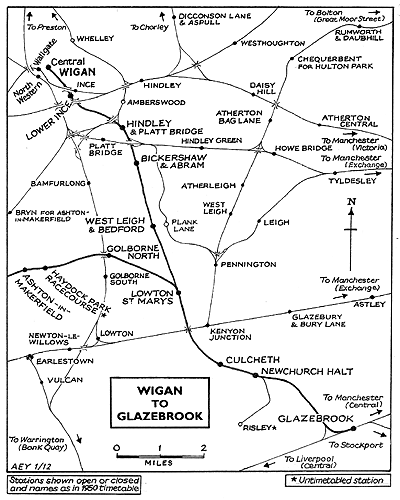 On 1 April 1884 passenger services were introduced and eight stations were opened including one at Wigan Darlington Street. On 1 April 1884 passenger services were introduced and eight stations were opened including one at Wigan Darlington Street.
Darlington Street was not very well situated for the town centre so on 30 October 1892 a half-mile extension was opened, and Wigan Central became the northern terminus. The station was located on the east of the town centre on the east side of Station Road.
Fronting onto Station Road there was a quite remarkable, flamboyant station building; in Gordon Biddle’s words it was ‘one of the most exotically ridiculous wooden stations to be erected in England and Wales’. Its L-shaped mixture was formed of gabled end and corner buildings in the style seen at Blacon, half brick and half timber with quite pretty little ogee cupolas flanking a longer wooden pavilion. The pavilion dominated the rest, its large gambrel roof surmounted by a domed balustraded cupola perched on the gabled apex, and linking these three features were plain sections having tall coupled chimneystacks styled in diamond-patterned Tudor.
 Behind the building there was a platform with a bay at its southern end. The platform was constructed with a timber face. Directly behind the building it was surfaced with planks but at its northern and southern ends it was backfilled with ash. A substantial ridge-and-furrow canopy of timber and glass provided shelter to passengers at the mid-point of the platform directly behind the building. An island platform was also found on the east side of the station. It had two faces and was constructed in a similar way to the west side. It also had a large canopy of timber and glass. Both platforms were physically connected by a walkway at the north end of the station. There was something of a temporary air to the platforms which was probably as a result of the MS&LR’s aspirations to a further northward extension as part of a route to Blackpool - plans that were never realised. Behind the building there was a platform with a bay at its southern end. The platform was constructed with a timber face. Directly behind the building it was surfaced with planks but at its northern and southern ends it was backfilled with ash. A substantial ridge-and-furrow canopy of timber and glass provided shelter to passengers at the mid-point of the platform directly behind the building. An island platform was also found on the east side of the station. It had two faces and was constructed in a similar way to the west side. It also had a large canopy of timber and glass. Both platforms were physically connected by a walkway at the north end of the station. There was something of a temporary air to the platforms which was probably as a result of the MS&LR’s aspirations to a further northward extension as part of a route to Blackpool - plans that were never realised.
The December 1895 timetable showed eight departures from and eight arrivals at Wigan Central Monday-to-Friday as shown in the table below. There were two extra trains in each direction on Saturdays and on Sundays there were three departures and three arrivals.
| Departures December 1895 |
To |
Arrivals December 1895 |
From |
| 7.05am |
Manchester Central |
8.17am |
Manchester Central |
| 8.42am |
Manchester Central |
9.35am |
Manchester Central |
| 9.50am |
Manchester Central |
11.04am |
Manchester Central |
| 11.45am |
Manchester Central |
1.26pm |
Manchester Central |
| 1.45pm |
Manchester Central |
2.42pm (Saturdays Only) |
Manchester Central |
| 3.05pm (Saturdays Only) |
Manchester Central |
4.33pm |
Manchester Central |
| 4.50pm |
Manchester Central |
6.51pm |
Manchester Central |
| 8.00pm |
Manchester Central |
7.50pm |
Manchester Central |
| 9.50pm |
Manchester Central |
10.27pm |
Manchester Central |
| 10.55pm (Saturdays Only) |
Manchester Central |
12.13am (Saturdays Only) |
Manchester Central |
On 1 August 1897 the MS&LR changed its name to the Great Central Railway (GCR).
When the Glazebrook and Wigan line had opened in 1879 it connected to the CLC Liverpool and Manchester route only in an easterly direction which meant that trains coming off the branch could run only towards Manchester. In 1900 a west curve was put in at Glazebrook which allowed trains to run to and from the Liverpool direction. By 1903 there were six trains in each direction between Wigan Central and Warrington Central as well as eight that ran between Wigan and Manchester Central.
On 1 January 1906 the GCR absorbed the WJR after it had obtained an Act for the purpose on 4 August 1905.
 The July 1922 timetable showed nine departures and nine arrivals Monday-to-Fridays. There were four extra trainsa in each direction on Saturdays but no trains on Sundays. Destinations served included Lowton St Mary, Glazebrook and Manchester Central. The July 1922 timetable showed nine departures and nine arrivals Monday-to-Fridays. There were four extra trainsa in each direction on Saturdays but no trains on Sundays. Destinations served included Lowton St Mary, Glazebrook and Manchester Central.
On 1 January 1923 Wigan Central and the line to Glazebrook became part of the London & North Eastern Railway (LNER). The CLC remained independent with the LNER holding two thirds of the shares. The London Midland & Scottish Railway held the other third.
During the 1920s and the 1930s Wigan Central continued to be served by local trains running to and from Manchester, Glazebrook and Lowton St Mary's.
By the late 1930s the island platform at Wigan Central had been demolished. The LNER obviously realised that the line would never be extended, and four platforms were not needed.
Unlike most lines during the Second World War scheduled passenger services to and from Wigan Central actually increased. This was because a large munitions facility was opened at Risley, and a branch from the LNER line was built to serve it. A new halt for munitions workers was opened on the line near Culcheth.
After the war services returned to a familiar pattern as shown in the 1947 LMS summer timetable below.
On 1 January 1948 the line from Glazebrook to Wigan Central, as part of the LNER network, was allocated to British Railways (BR) Eastern Region. From 30 November 1948 various adjustments were made to BR regional boundaries, and Glazebrook to Wigan Central was transferred to the London Midland Region, as they had, along with the branch to St Helens Central, been entirely detached from the rest of the BR(ER) system.
Although diesel multiple units (DMUs) were introduced onto the CLC main line and many of the local routes in 1960 the Wigan Central service remained steam-hauled. The summer 1962 timetable showed eleven departures and thirteen arrivals Monday-to-Friday as seen in the table below. On Saturdays there were two extra trains in each direction.
| Departures Summer 1962 |
To |
Arrivals Summer 1962 |
From |
| 5.04am |
Irlam |
6.49am |
Irlam |
| 6.10am |
Manchester Central |
7.45pm |
Partington |
| 6.21am |
Partington |
8.39am |
Manchester Central |
| 7.05am |
Manchester Central |
10.37am |
Irlam |
| 7.55am |
Manchester Central |
12.51pm (Saturdays Only) |
Trafford Park |
| 9.00am |
Manchester Central |
1.32pm |
Manchester Central |
| 11.42am (Saturdays Only) |
Manchester Central |
2.10pm (Saturdays Only) |
Manchester Central |
| 1.00pm |
Irlam |
2.49pm (Saturdays Only) |
Irlam |
| 2.00pm |
Manchester Central |
2.51pm (Saturdays Excepted) |
Irlam |
| 5.05pm |
Manchester Central |
4.36pm |
Manchester Central |
| 7.38pm |
Manchester Central |
5.49pm (Saturdays Excepted) |
Partington |
| 9.05pm |
Manchester Central |
5.51pm (Saturdays Only) |
Irlam |
| 11.12pm (Saturdays Only) |
Irlam |
6.02pm (Saturdays Excepted) |
Irlam |
| |
|
7.07pm |
Manchester Central |
| |
|
8.04pm |
Manchester Central |
| |
|
9.31pm |
Manchester Central |
| |
|
10.52pm |
Irlam |
| |
|
12.21pm (Saturdays Only ) |
Irlam |
The Reshaping of British Railways (‘Beeching’) report of March 1963 recommended the withdrawal of passenger services between Glazebrook and Wigan Central and the closure of all stations. The official closure proposal was published a short time later, on 11 July 1963. There was opposition to the closure and it was pointed out to British Railways that the line could be run more  efficiently if DMUs were used. British Railways reported that there were not sufficient DMUs to cover the timetable. The Transport Users’ Consultative Committee hearing ended on 8 January 1964, As soon as Ernest Marples, Secretary of State for Transport, had given his approval on 23 July 1964 to close the line, DMUs did make an appearance. efficiently if DMUs were used. British Railways reported that there were not sufficient DMUs to cover the timetable. The Transport Users’ Consultative Committee hearing ended on 8 January 1964, As soon as Ernest Marples, Secretary of State for Transport, had given his approval on 23 July 1964 to close the line, DMUs did make an appearance.
The last services ran on 31 October 1964 and Wigan Central closed to passengers on 2 November 1964. It continued in use for goods until 5 April 1965 after which the line between Lowton St Mary's and Wigan Central closed completely. It was lifted shortly after closure.
The station was demolished in 1973 and its site was later developed with a shopping centre and multi-storey car park.
Tickets by Michael Stewart.
Sources:
- The Cheshire Lines Committee, by P Bolger, Heyday Publishing Company 1984.
- Bradshaw Timetable December 1895.
- Bradshaw Timetable July 1922.
- LMS Timetable Summer 1932..
- BR (LMR) Summer Timetable 1962.
- Cheshire Lines Committee Signal Box Register, M J Addison & J D Dixon 1996.
- Encyclopaedia of British Railway Companies, by Christopher Awdrey, Guild Publishing 1990.
- Victorian Stations, by Gordon Biddle, David & Charles 1973.
To see the other
stations on the Wigan Central - Glazebrook line
click on the
station name: Lower
Ince, Hindley
South,
Bickershaw
& Abram, West
Leigh & Bedford, Lowton
St. Marys, Culcheth
& Newchurch
Halt.
|

old1.jpg)
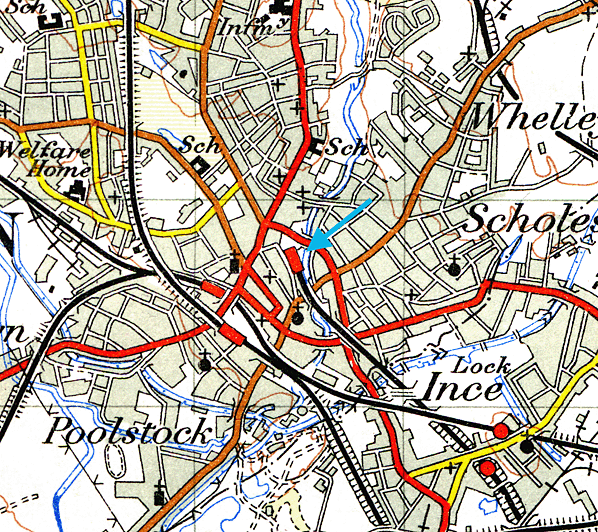
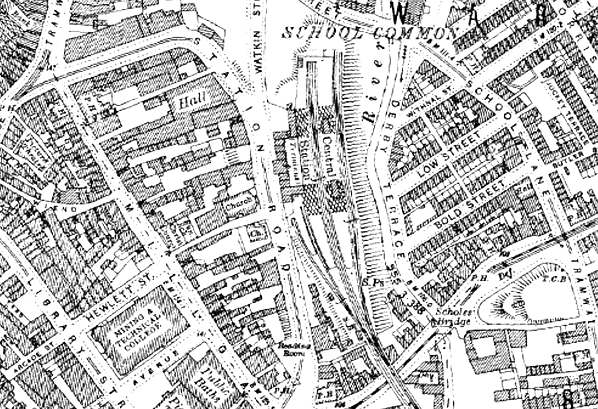
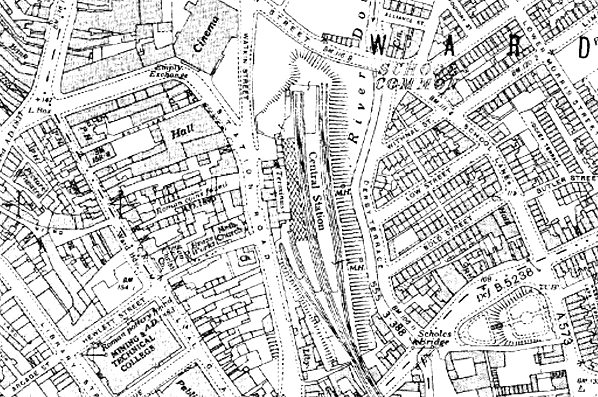
old5.jpg)
old3.jpg)
old4.jpg)
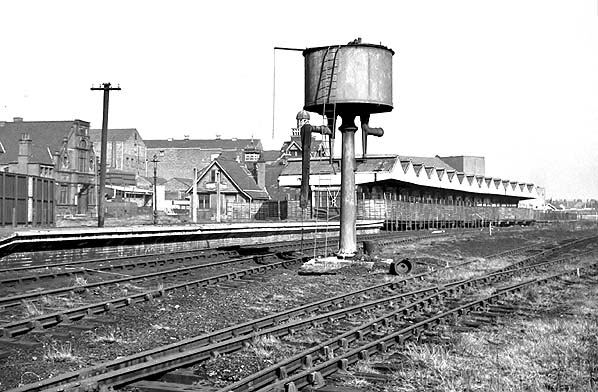
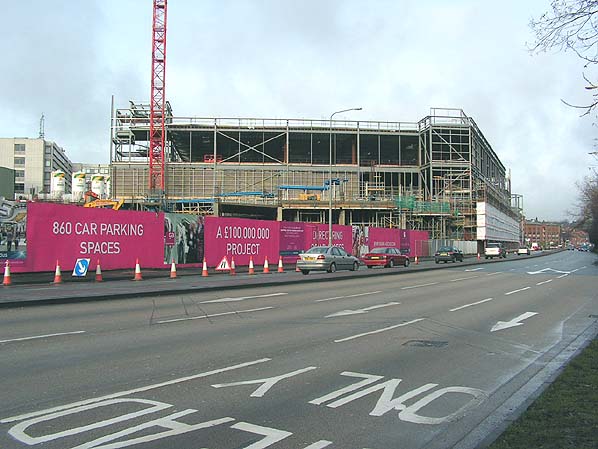 The
site of Wigan Central station looking north from a similar viewpoint to the picture above in January 2006. Nothing survived to show there had ever been a railway at this location.
The
site of Wigan Central station looking north from a similar viewpoint to the picture above in January 2006. Nothing survived to show there had ever been a railway at this location. Home
Page
Home
Page
 On 1 April 1884 passenger services were introduced and eight stations were opened including one at Wigan Darlington Street.
On 1 April 1884 passenger services were introduced and eight stations were opened including one at Wigan Darlington Street.  Behind the building there was a platform with a bay at its southern end. The platform was constructed with a timber face. Directly behind the building it was surfaced with planks but at its northern and southern ends it was backfilled with ash. A substantial ridge-and-furrow canopy of timber and glass provided shelter to passengers at the mid-point of the platform directly behind the building. An island platform was also found on the east side of the station. It had two faces and was constructed in a similar way to the west side. It also had a large canopy of timber and glass. Both platforms were physically connected by a walkway at the north end of the station. There was something of a temporary air to the platforms which was probably as a result of the MS&LR’s aspirations to a further northward extension as part of a route to Blackpool - plans that were never realised.
Behind the building there was a platform with a bay at its southern end. The platform was constructed with a timber face. Directly behind the building it was surfaced with planks but at its northern and southern ends it was backfilled with ash. A substantial ridge-and-furrow canopy of timber and glass provided shelter to passengers at the mid-point of the platform directly behind the building. An island platform was also found on the east side of the station. It had two faces and was constructed in a similar way to the west side. It also had a large canopy of timber and glass. Both platforms were physically connected by a walkway at the north end of the station. There was something of a temporary air to the platforms which was probably as a result of the MS&LR’s aspirations to a further northward extension as part of a route to Blackpool - plans that were never realised.  The July 1922 timetable showed nine departures and nine arrivals Monday-to-Fridays. There were four extra trainsa in each direction on Saturdays but no trains on Sundays. Destinations served included Lowton St Mary, Glazebrook and Manchester Central.
The July 1922 timetable showed nine departures and nine arrivals Monday-to-Fridays. There were four extra trainsa in each direction on Saturdays but no trains on Sundays. Destinations served included Lowton St Mary, Glazebrook and Manchester Central.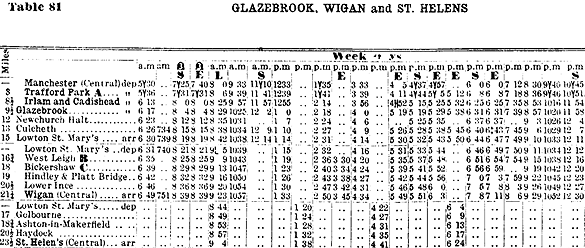
 efficiently if DMUs were used. British Railways reported that there were not sufficient DMUs to cover the timetable. The Transport Users’ Consultative Committee hearing ended on 8 January 1964, As soon as Ernest Marples, Secretary of State for Transport, had given his approval on 23 July 1964 to close the line, DMUs did make an appearance.
efficiently if DMUs were used. British Railways reported that there were not sufficient DMUs to cover the timetable. The Transport Users’ Consultative Committee hearing ended on 8 January 1964, As soon as Ernest Marples, Secretary of State for Transport, had given his approval on 23 July 1964 to close the line, DMUs did make an appearance. 

